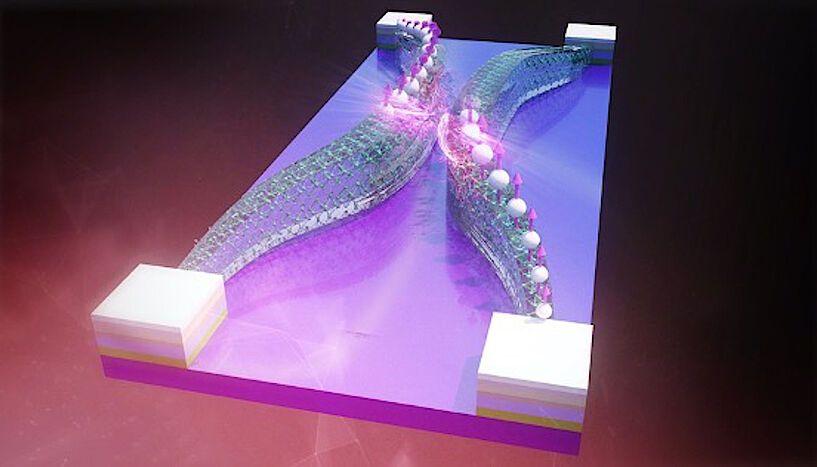Oct 21 2020
Under the guidance of TU Kaiserslautern (TUK) and the University of Vienna, scientists have been successful in developing a fundamental building block of computer circuits that uses magnons to transfer information, instead of electrons.
 The directional coupler with a visible atomic structure is depicted. Spin wave jumps from one nanowire conduit to another nanowire at the point where the conduits are getting closer one to another. Image Credit: © Niels Paul Bethe.
The directional coupler with a visible atomic structure is depicted. Spin wave jumps from one nanowire conduit to another nanowire at the point where the conduits are getting closer one to another. Image Credit: © Niels Paul Bethe.
The new “magnonic half-adder” reported in the Nature Electronics journal needs just three nanowires, and very less energy compared to the advanced computer chips.
A physicist group has achieved a breakthrough in the search for smaller and more energy-efficient computing: they designed an integrated circuit by making use of a magnetic material and magnons to send binary data, the 1s and 0s that are the basis of existing smartphones and computers.
The newly developed circuit is very tiny, with a flawless 2D design that needs around 10 times less energy compared to the most sophisticated computer chips available at present, which are based on CMOS technology.
Although the present magnon configuration is not as quick as CMOS, the successful model can be further investigated for other applications, like neuromorphic or quantum computing
Successful Collaboration
The prototype is the result of four years of hard work, which was financially supported via Andrii Chumak’s European Research Council (ERC) Starting Grant, and close collaboration with Jun.-Prof. Dr. Philipp Pirro at TUK, and Dr. Qi Wang, who is now a postdoc at the University of Vienna. Univ.-Prof. Chumak began the study at TUK and currently heads a research group at the University of Vienna.
We are very happy since we managed to do what was planned several years ago and it works even better than we expected. We see now that magnonics circuits can be as good as CMOS, but this is probably not yet enough if you want to trigger industry. I would assume you have to be still at least 100 times smaller and faster.
Dr Andrii Chumak, Professor, University of Vienna
When Chumak initially suggested the magnon circuit, his design was highly complicated. He gives credits to Wang, the lead author of the study, for making the design “at least 100 times better.”
“But this circuit opens up fantastic opportunities beyond binary data, for example to quantum magnonic computing at very low temperatures. We are also interested in adapting the circuit for neuromorphic magnonic computers inspired by the functionality of our brain,” added Pirro.
How it Works
The size of the nanocircuit components is less than 1 μm, much thinner compared to a strand of human hair and barely visible even under a microscope.
It includes three nanowires made of a magnetic material known as yttrium iron garnet. The wires are placed exactly in tandem with each other to make two “directional couplers,” which lead magnons via the wires.
Magnons are quanta of spin waves—imagine them as similar to ripples on the surface of a pond when a rock is thrown; but here, the waves are developed by distortions in the magnetic order of solid material present on the quantum level.
A lot of time and effort was involved in finding the best nanowire length and spacing to produce the ideal results. Wang worked on the project for his Ph.D. at TUK.
Wang states, “This is the 3rd or 4th design, I ran a few hundred simulations for different types of half-adders.”
When the spin-wave reaches the first coupler, where two wires are kept very close, it is split into half. One half of the wave proceeds to the second coupler, where it bounces back and forth between the wires.
Based on the amplitude, the wave will either exit the top or bottom wire, corresponding to binary “1” or “0,” respectively.
The circuit includes two directional couplers that add two streams of data together, thus forming a “half-adder,” one of the most versatile components of computer chips. Millions of such circuits can be integrated to carry out highly difficult functions and calculations.
What typically requires hundreds of components and 14 transistors in regular computers, here only requires three nanowires, a spin wave, and nonlinear physics.
Dr Philipp Pirro, Junior Professor, TU Kaiserslautern
Future Applications
Pirro, who now heads spintronic computing at TUK in the frames of the collaborative research center “Spin+X,” will investigate the use of the magnon circuit for neuromorphic computing, which treats data processing not as binary, but more similar to the human brain.
Spin waves are highly suitable for the more complicated systems and can carry much more information since they have two parameters—amplitude and phase, which are the wave height and the wave angle, respectively.
In this study, phase was not used as a variable to simplify binary data processing.
If this device can already compete with CMOS, even if it is not using the full power of the wave-based approach, then we can be quite confident a scheme using the full power of the spin wave can be more efficient than CMOS for certain tasks. And the ultimate goal, of course, is to combine the strengths of both CMOS and magnonics technologies together.
Dr Philipp Pirro, Junior Professor, TU Kaiserslautern
Journal Reference:
Wang, Q., et al. (2020) A magnonic directional coupler for integrated magnonic half-adders. Nature Electronics. doi.org/10.1038/s41928-020-00485-6.